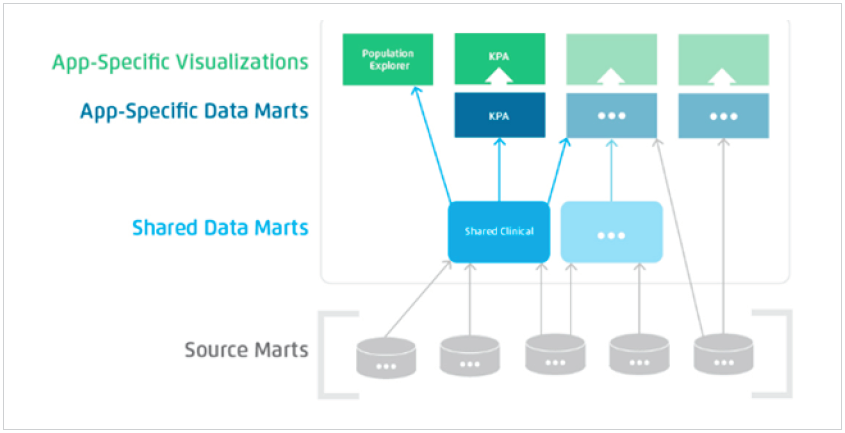Changing payment models are putting pressure on clinicians to have instant access to actionable information about their patients, their performance, and their potential to close gaps in care. Read how Orlando Health recognized the value of immediate access to adaptive, integrated data, giving users access to rapidly deployed data in consumable, actionable visualizations.
Changes in payment models are putting pressure on clinicians to close gaps in care. To do this, they need instant access to actionable information about their patients and their own performance. However, many electronic health records and business intelligence systems are still grappling with how to deliver the insights necessary to revolutionize the way providers work.
Orlando Health, a Florida-based, not-for-profit health system made up of eight hospitals and 50 clinics, found its enterprise data model difficult to scale, making it challenging to gain insights from its healthcare data. Building upon its analytics platform, Orlando Health recognized the value of immediate access to adaptive, integrated healthcare data that could be rapidly deployed in consumable, actionable visualizations to address a wide spectrum of business needs and use cases, and embraced a next-generation data model.
Healthcare organizations have an urgent need for actionable data and analytics to support a variety of use cases across the enterprise, but have struggled to access, integrate, and make the vast volumes of data useable. Changing payment models are one use case putting pressure on clinicians to have instant access to actionable information about their patients and their performance in order to close potential gaps in care. However, many electronic health records and business intelligence systems are still grappling with how to deliver at-a-glance insights that could potentially revolutionize the way providers work.1
To prepare for a future in which big data is at the core of each and every function, healthcare organizations must be poised to take advantage of a patient-centered ecosystem in which timely, accurate, and meaningful data drives the informed decisions of clinicians and helps to produce better outcomes across the entire continuum of care with the help of analytics.2 One of the biggest barriers to achieving this vision is the lack of data structures that can be shared across applications while also allowing for scalability and consistency. Without these structures, accessing and integrating data when it resides in multiple disparate sources, such as EMRs, billing, claims, health information exchanges, and financial systems is nearly impossible.
Orlando Health, one of Florida’s most comprehensive private, not-for-profit healthcare networks consisting of eight hospitals and 50 clinics, began its journey to making actionable data available across the organization when it made the transition from a legacy data warehouse solution to the Health Catalyst analytics platform, and subsequently to the Health Catalyst® Data Operating System (DOS™) platform.
Orlando Health’s legacy system employed an enterprise model that was rigid and cumbersome to manage. Significant changes to data models would take up to 90 days to implement. Not only were these changes time intensive, but they involved extensive resources as well, requiring a data modeler, QA tester, analyst, subject matter experts, and product engineers to implement the changes.
Over time, cumulative changes resulted in an enterprise model that was unwieldy and difficult to upgrade. The health system needed the ability to rapidly acquire and link disparate healthcare data sources in various ways in order to answer critical clinical and business questions.
The DOS platform acts as the foundation for data-based technology at Orlando Health. DOS is a data-first, analytics and application platform that transforms raw data from virtually any data source into “deep data”—data that is meaningful and actionable, leading to actual business value at a lower cost. DOS accomplishes this by integrating and analyzing critical data from over 200 of the most widely used data sources, and delivering real-time decision support within the existing workflows of clinicians, administrators, and other healthcare professionals, breaking out of the walls of dashboards and reports.
Shared data marts are a key component of DOS. While traditional data marts have been an important element of a data warehousing strategy, shared data marts are the next generation of architectural components, supporting late-binding technology that allows for the sharing, aggregation, and calculation of data between Source Marts (see Figure 1).

Shared data marts deliver domain-specific data models that provide a repeatable and scalable foundation for Orlando Health to serve up consumable data, and make it easier for the organization to implement updates and upgrades.
Colocation and aggregation occur in the same shared data marts, which enables Orlando Health to create organization-wide standards on data for reporting. This dispels confusion when the same data element appears more than once, allowing analysts to easily identify and resolve data issues that were unsolvable in the past. By using the shared data marts, Orlando Health is able to promote:
Orlando Health has seen significant improvements in the ability to quickly and easily solve data problems utilizing shared data marts. In one example, when the discharge date of a patient changed, it was added as a new additional record in the core measure report, causing mismatched numerators and confusion for end users. Fixing this frustrating problem required almost eight hours of research by the analysts, followed by additional time to clean up the records from the EDW table. With the flexibility of the new platform, the analysts no longer need to spend hours on this extra maintenance.
The first time it identified an opportunity related to pulling in DRG data from its affinity source mart, Orlando Health was pleased to discover that it was able to immediately identify and address how the model would need to be updated. What once was an extremely onerous task was now streamlined and deployed quickly with the first run of the updated logic occurring on the same day.
Another vexing problem solved with shared data marts centered on delays in changing nursing units in the database when patients transferred to another unit. The ongoing issue had caused some departments to resist adoption of the data warehouse. Orlando Health pulled the nursing unit changes into the Instant Data Entry Application and provided a type two table with start and stop dates for specific nursing units. This data was then integrated directly into the SharedClinical shared data mart, which allowed for seamless integration of the data into all of the applications.
Orlando Health implemented the SharedClinical and SharedPerson shared data marts, loading ten sources worth of data into the platform in under six months. These shared data marts deliver standard data elements that are populated from multiple sources and are already bringing value to the health system. Results include:
In addition, the speed at which applications can be spun up has increased, as familiarity with the shared data marts has also increased. For instance, Shared Clinical was validated during a four-week window early in implementation. Orlando Health team members provided aggregated and account level validation, and as the use of Shared Clinical increased, it became the trusted hub for the self-service approach at Orlando Health.
“When there are a lot of source systems, and you try to join the data, it is important to have standardized and clean data for reporting and one source of truth. Our ability to search for data elements is awesome.”
– Suresh Gunda, Data Warehouse Developer
Orlando Health plans to add additional shared data marts and open its data models—and its data—to even more of the health system, leveraging shared data marts as the hub of these self-service models, extending the models where needed. Additional hospitals with disparate EMRs and data sources will be able to be integrated into a single reportable view, enabling data integration and systemwide reporting.




